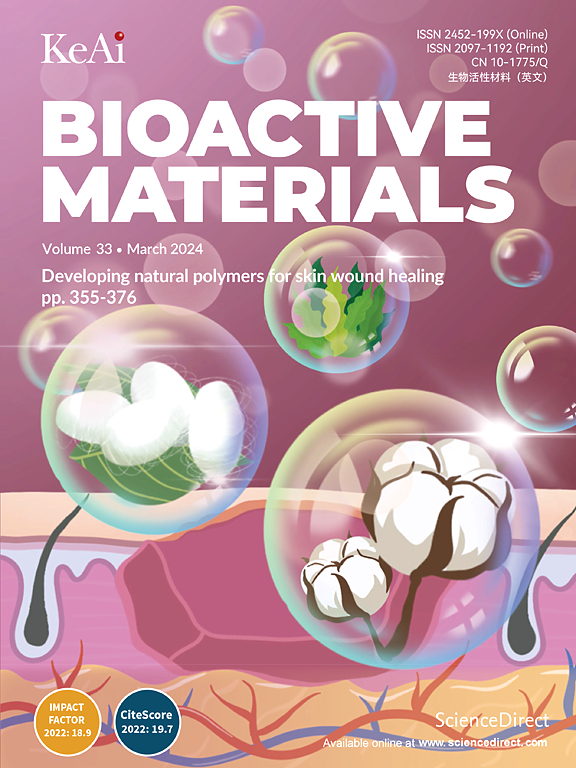自然电位差诱导锌基多金属骨植入物功能优化机制。
IF 18
1区 医学
Q1 ENGINEERING, BIOMEDICAL
引用次数: 0
摘要
锌基生物可降解金属(BMs)被认为是一种革命性的骨植入材料。然而,它们的临床应用受到力学性能不足、体内降解延迟和过量诱导Zn2+毒性的限制。本文采用创新的多材料增材制造技术(MMAM)构建了锌/钛(Ti)异质结构复合材料。锌在复合材料中的生物降解和生物功能表现出有趣的特征。锌和钛之间自然存在约300毫伏的电位差。这种自然电位差引发电偶腐蚀,导致Zn的降解加速2.7倍。加速降解诱导Zn2+的过量释放增强了抗菌功能。自然电位差产生的电压信号也通过激活PI3K-Akt信号通路促进体外成骨分化,抑制体内过量Zn2+的毒性,显著促进骨再生。此外,MMAM技术允许在特定区域部署组件。在未来,通过结构设计,Ti和Zn可以分别部署在骨种植体的主要和非承重区域,从而实现功能分级应用,以克服锌基脑转移物力学性能不足的问题。本研究阐明了多金属骨植入物的功能优化机制,有望打破锌基骨植入物的应用困境。本文章由计算机程序翻译,如有差异,请以英文原文为准。

Natural potential difference induced functional optimization mechanism for Zn-based multimetal bone implants
Zn-based biodegradable metals (BMs) are regarded as revolutionary biomaterials for bone implants. However, their clinical application is limited by insufficient mechanical properties, delayed in vivo degradation, and overdose-induced Zn2+ toxicity. Herein, innovative multi-material additive manufacturing (MMAM) is deployed to construct a Zn/titanium (Ti) hetero-structured composite. The biodegradation and biofunction of Zn exhibited intriguing characteristics in composites. A potential difference of about 300 mV naturally existed between Zn and Ti. This natural potential difference triggered galvanic coupling corrosion, resulting in 2.7 times accelerated degradation of Zn. The excess release of Zn2+ induced by accelerated degradation enhanced the antibacterial function. A voltage signal generated by the natural potential difference also promoted in vitro osteogenic differentiation through activating the PI3K-Akt signaling pathway, and inhibited the toxicity of overdose Zn2+ in vivo, significantly improving bone regeneration. Furthermore, MMAM technology allows for the specific region deployment of components. In the future, Ti and Zn could be respectively deployed in the primary and non-load-bearing regions of bone implants by structural designs, thereby achieving a functionally graded application to overcome the insufficient mechanical properties of Zn-based BMs. This work clarifies the functional optimization mechanism for multimetal bone implants, which possibly breaks the application dilemma of Zn-based BMs.
求助全文
通过发布文献求助,成功后即可免费获取论文全文。
去求助
来源期刊

Bioactive Materials
Biochemistry, Genetics and Molecular Biology-Biotechnology
CiteScore
28.00
自引率
6.30%
发文量
436
审稿时长
20 days
期刊介绍:
Bioactive Materials is a peer-reviewed research publication that focuses on advancements in bioactive materials. The journal accepts research papers, reviews, and rapid communications in the field of next-generation biomaterials that interact with cells, tissues, and organs in various living organisms.
The primary goal of Bioactive Materials is to promote the science and engineering of biomaterials that exhibit adaptiveness to the biological environment. These materials are specifically designed to stimulate or direct appropriate cell and tissue responses or regulate interactions with microorganisms.
The journal covers a wide range of bioactive materials, including those that are engineered or designed in terms of their physical form (e.g. particulate, fiber), topology (e.g. porosity, surface roughness), or dimensions (ranging from macro to nano-scales). Contributions are sought from the following categories of bioactive materials:
Bioactive metals and alloys
Bioactive inorganics: ceramics, glasses, and carbon-based materials
Bioactive polymers and gels
Bioactive materials derived from natural sources
Bioactive composites
These materials find applications in human and veterinary medicine, such as implants, tissue engineering scaffolds, cell/drug/gene carriers, as well as imaging and sensing devices.
 求助内容:
求助内容: 应助结果提醒方式:
应助结果提醒方式:


